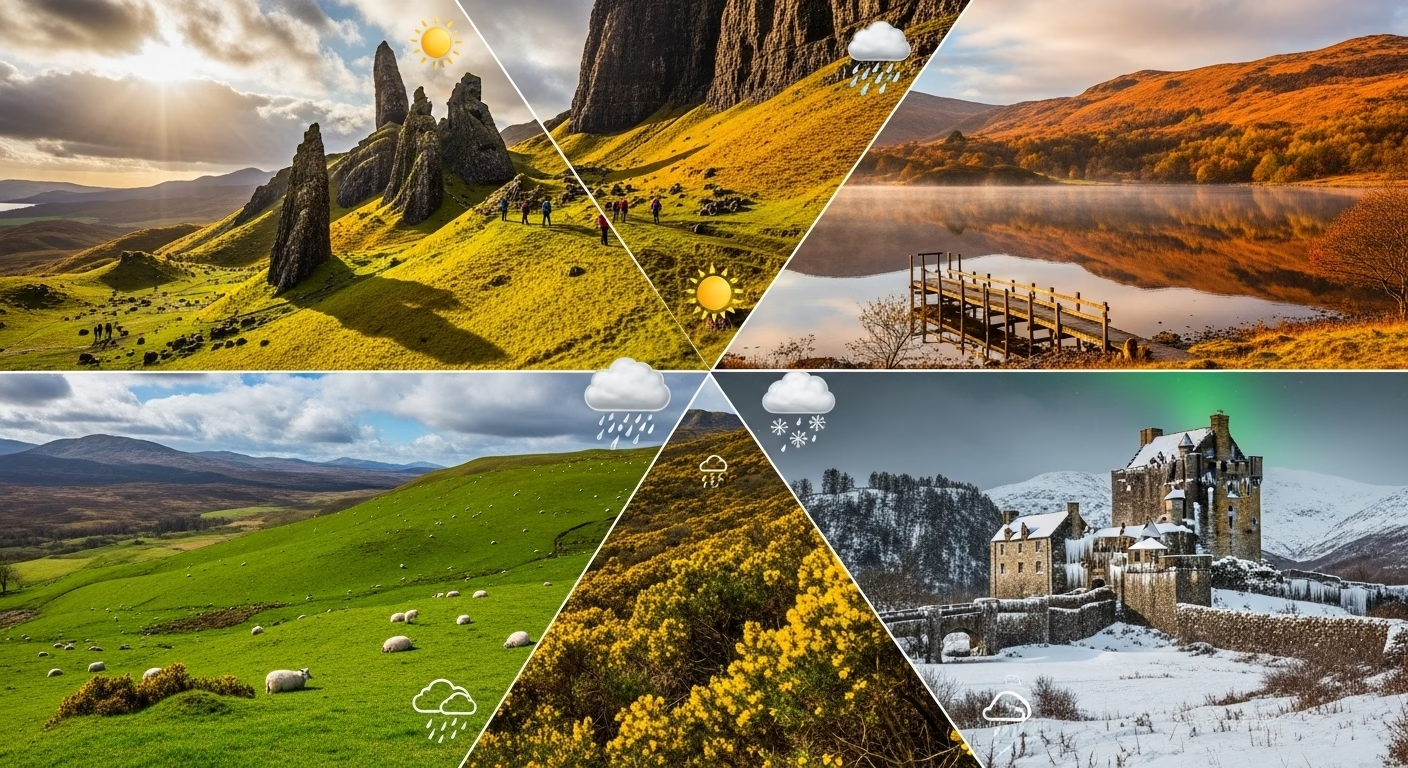
Ask anyone about the best time to visit Scotland, and you’ll likely get a wry smile and a comment about packing a raincoat. And while they’re not wrong about the weather being unpredictable as hell, the truth is far more exciting than that tired stereotype suggests.
Here’s the deal: the best time to visit Scotland isn’t a single month—it’s the season that perfectly matches your travel dreams. Are you chasing those legendary 18-hour summer days for epic Highland hikes? Dreaming of cozy pub firesides with snow dusting ancient castles? Or maybe you want those stunning autumn colors without battling selfie-stick wielding tour groups?
After two decades of dragging my camera gear through Scottish weather that changes faster than a teenager’s mood, I’ve learned that timing can make or break your Highland adventure. This guide breaks down everything you need to know, month by month, to choose your perfect season for visiting Scotland. We’ll cover weather patterns, crowd levels, prices, and—yes—even those infamous blood-sucking midges that nobody warns you about until it’s too late.
Ready to master the art of Scottish timing? Let’s start with our complete Scotland Travel Guide: Complete Planning Checklist for US Travelers to get your Highland adventure off to the perfect start.
Quick Answers: The Best Time to Visit Scotland For…
Let me cut through the bullshit and give you the quick answers before we dive deep:

- For the Best Weather: Summer (June-August) delivers the warmest temperatures and those almost-midnight sunsets that’ll mess with your sleep schedule in the best way possible
- For Smallest Crowds & Best Prices: Shoulder seasons (April-May and September-October) are your sweet spot for authentic experiences without breaking the bank
- To See the Northern Lights: Winter (December-February) is your only shot, and you’ll need to head north of the central belt
- To Avoid Midges: Any month outside June-August, because trust me, you don’t want to meet these tiny vampires
Before planning your Highland adventures, make sure you’re prepared with our essential Scottish Highland Packing List: What to Bring for Every Season – because Scottish weather doesn’t mess around.
Best Time to Visit Scotland for Different Travel Goals
Look, not everyone wants the same Scotland experience. Some of you are weather-obsessed sunshine chasers, others are perfectly happy trading blue skies for empty castles and cheap hotel rooms. Here’s how to pick the best time to visit Scotland based on what actually matters to you.
For the Best Weather (If You’re Weather-Sensitive)
When: Late May through early September, with June and July being your statistical jackpot months.
Let’s be brutally honest: Scotland will never be the Mediterranean. But during summer, you’ll get temperatures hovering around 15-20°C (59-68°F), which is legitimately pleasant for hiking, castle exploring, and not feeling like a popsicle. The real prize? Those impossibly long days where sunset doesn’t happen until after 10 PM, giving you basically two extra hours of adventure time.
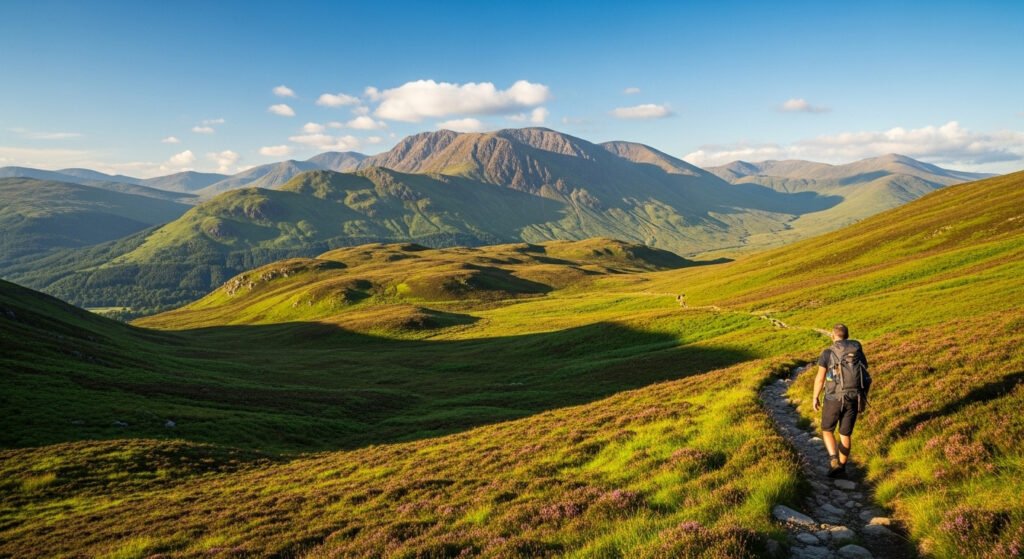
The catch? Everyone else figured this out too. Edinburgh turns into a tourist conga line, and Highland parking lots fill by 9 AM. But if weather predictability matters more to you than having Eilean Donan Castle to yourself, this is your window.
Pro move: Late May or early September splits the difference—you get 70% of summer’s good weather with 50% of the crowds.
For Avoiding Crowds (If You Value Your Personal Space)
When: November through March, with November and February being the sweet spots.
Winter Scotland is for people who understand that atmospheric beats Instagram-perfect every damn time. You’ll have Edinburgh Castle essentially to yourself, Highland trails where you won’t see another soul for hours, and that authentic Scotland experience where locals actually have time to chat with you.
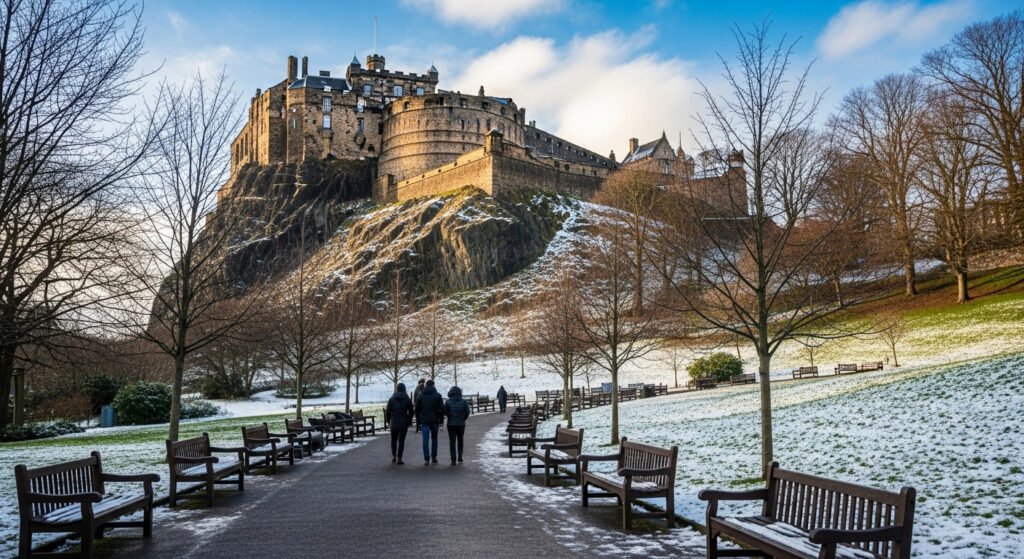
The reality check: Days are short as hell (7-8 hours of daylight), temperatures hover just above freezing, and that romantic Highland rain becomes less “cozy” and more “persistently damp.” But if you pack proper waterproofs and embrace the moody weather, winter Scotland reveals itself in ways summer tourists never see.
Bonus: Accommodation costs drop 60-70%. That Edinburgh hotel charging £200 in August? £60 in January. Your credit card will thank you.
For Budget Travelers (If Money Actually Matters)
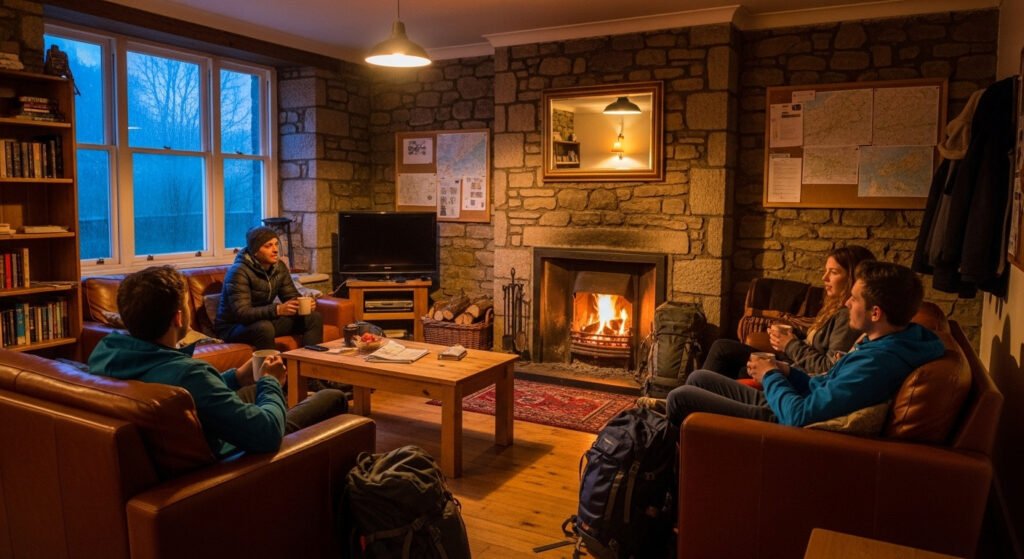
When: November through February (avoiding Christmas week and Hogmanay), with November being the absolute cheapest.
Here’s the truth nobody tells you: Scotland outside peak season is stupidly affordable. We’re talking hostel beds for £15, hotel rooms for £30-50, and rental cars for half the summer rate. Even restaurants offer “winter warmer” specials to attract customers.
I’ve done Scotland on £40/day in November—hostels, grocery store meals, free walking tours, and still hit all the major sights. Try that in August and you’ll blow through £40 before lunch.
The trade-off: Short days mean less sightseeing time, some Highland roads close due to snow, and you’ll need to pack more gear (which might cost you baggage fees). But if your budget is tight, winter transforms Scotland from “expensive European destination” to “actually affordable.”
Money-saving hack: Book accommodations with kitchens. Scottish grocery stores are cheap, and cooking your own meals saves £20-30 daily.
For Seeing Northern Lights (If You’re Chasing Aurora)
When: December through February, with January and February statistically offering the best shot.
Let’s manage expectations: Scotland isn’t Iceland. You’re not going to see dancing green curtains every clear night. Scottish aurora are subtle, requiring pitch-black locations, clear skies, and solar activity cooperation—three things that rarely align.
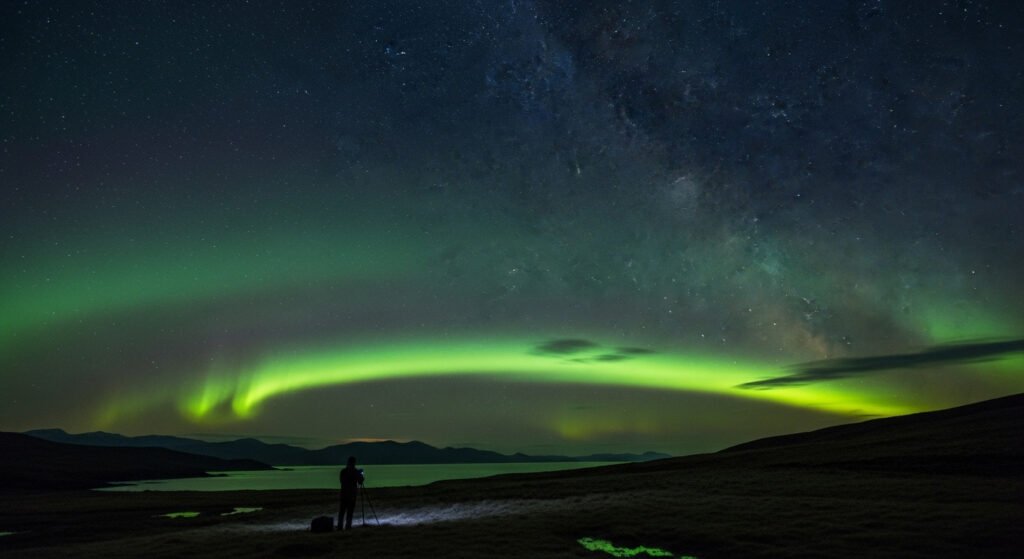
Your best bet for actually seeing the Northern Lights in Scotland means heading to Shetland Islands, Orkney, or the far north coast of Caithness and Sutherland. Even then, locals who’ve lived there decades might have only seen strong displays a dozen times.
But here’s the thing: when they do appear, it’s fucking magical. And winter Scotland offers enough other atmospheric experiences (snow-dusted castles, roaring pub fires, empty landscapes) that even if the aurora don’t cooperate, you won’t feel cheated.
Reality check: Plan your trip around experiencing winter Scotland, and consider Northern Lights a potential bonus, not the main event. You’ll enjoy yourself way more with this mindset.
For Avoiding Midges (If You Hate Being Eaten Alive)
When: September through May—literally any month outside peak midge season.
Midges are Scotland’s tiniest terrorists, and I’m not being dramatic. These microscopic biting bastards can turn a perfect Highland sunset into a sprint back to your car, arms flailing, cursing your life choices.
They emerge late May and reach peak annoyance in July-August, particularly in the Highlands and Islands near water. Calm, warm, humid evenings—exactly the conditions you want for enjoying Scotland’s long summer days—are when they’re most vicious.
The solution: Visit Scotland outside June-August, and midges literally aren’t a factor. Spring and autumn offer almost identical daylight and activities without the bloodsucking welcome committee. Cities like Edinburgh and Glasgow rarely have midges regardless of season.
If you must visit during midge season, stock up on Smidge repellent (the Scottish gold standard), avoid dawn and dusk in boggy areas, and pray for wind. Midges hate breezy conditions almost as much as you’ll hate them.
A Snapshot of the Scottish Seasons
Spring (March-May): The Awakening
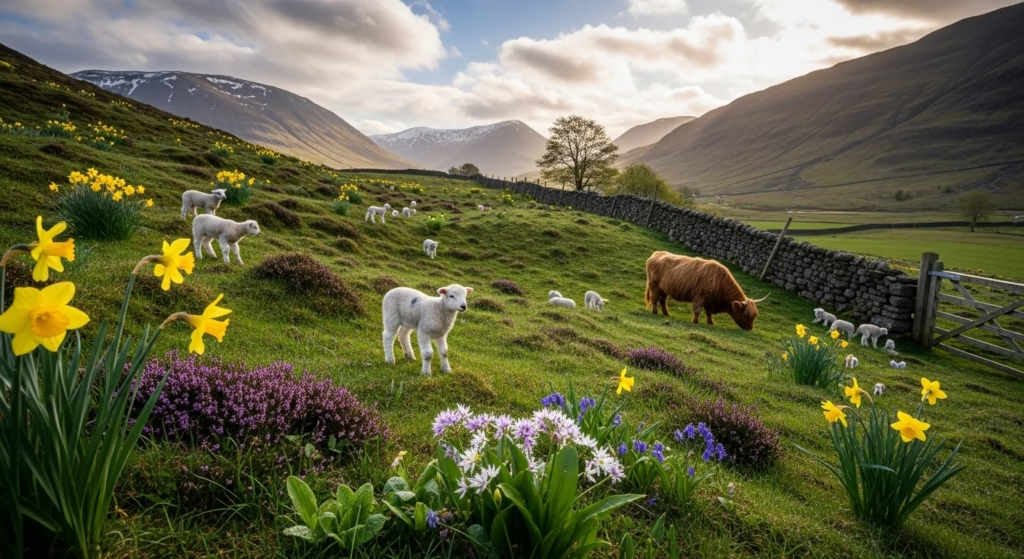
Spring in Scotland feels like the country’s slowly stretching and yawning after a long winter nap. The hills explode with new green life, baby lambs bounce around like they’re auditioning for a Disney movie, and the days start getting noticeably longer. It’s fucking magical, honestly.
This is prime time for serious hikers looking to tackle the best trails without summer crowds. Check out our detailed guide to Best Scottish Highlands Hiking Trails: Local’s Guide to Epic Adventures to discover those hidden gems that most tourists never find.
Summer (June-August): The Midnight Sun

Summer is when Scotland puts on its finest show. Those legendary 18-hour days mean you’ll be hiking at 9 PM wondering why you’re not tired yet. Just remember to pack your midge repellent—these tiny bastards come with the territory.
August brings the world-famous Edinburgh Festival, and if you’re planning to experience this cultural madness, our insider’s Edinburgh Festival Guide: Insider Tips for First-Time Visitors will help you navigate the chaos like a pro.
Autumn (September-November): The Golden Hour
Autumn in Scotland is pure poetry. The hills catch fire with colors that make you question whether Instagram filters were inspired by Highland autumns. It’s crisp enough for cozy pub nights but still warm enough for proper exploring.

Winter (December-February): The Dramatic & Cozy
Winter is Scotland’s most dramatic season. Snow-dusted castles, roaring pub fireplaces, and if you’re lucky and head far enough north, those elusive Northern Lights dancing across the sky.

Scotland Month by Month: A Detailed Breakdown
Weather data sourced from UK Met Office historical records and VisitScotland official tourism statistics.
Best Time to Visit Scotland from the US (What American Travelers Need to Know)
Planning your Scotland trip from the States? Timing matters even more when you’re crossing the Atlantic. Here’s what you need to know that generic “best time” guides won’t tell you.

Aligning with US Vacation Time
Let’s be real: most Americans are working with limited vacation days, and those days are precious. The best time to visit Scotland from the US depends partly on maximizing your time off.
Memorial Day Weekend (Late May): Add a few vacation days to this long weekend, and you’ve got a solid 10-12 day Scotland trip. Late May is phenomenal—spring weather, no midges yet, and Edinburgh hasn’t hit peak tourist insanity. You’ll fly out Thursday or Friday, have over a week of exploring, and be back for the following week.
Labor Day Weekend (Early September): This is my personal favorite hack. September is arguably Scotland’s best month (warm enough, way less crowded than summer, stunning early autumn colors), and you can bookend your trip with US holidays to maximize vacation days. Many Americans miss this opportunity.
Thanksgiving Week: Controversial opinion, but hear me out. Scotland in late November is cheap as hell, Christmas markets are starting up, and you’re trading one hectic family dinner for Highland castles. Not for everyone, but for those who’d rather escape than overeat, this works brilliantly.
Summer (June-August): Yes, it’s the busiest and most expensive time to visit Scotland, but it’s also when most American families can travel. If you’re constrained by school schedules, focus on June or late August to avoid peak July madness.
Flight Availability Considerations
The best time to visit Scotland from the US also depends on direct flight availability. Direct flights from major US cities (New York, Chicago, Boston) to Edinburgh run year-round, but seasonal routes (Atlanta, Washington DC) only operate May through October.
Having a direct flight makes a massive difference when you’re already dealing with 6-8 hours of time difference. That connection through London or Dublin adds 3-5 hours to your journey and another opportunity for delayed bags.
If you’re flying from a city without direct Edinburgh flights, consider timing your trip for the May-October window when more routes operate, or be prepared for that connection hub experience.
Currency Exchange Rate Timing
This sounds nerdy, but it actually matters. The pound-to-dollar exchange rate fluctuates, and timing your trip when the dollar is stronger can save you hundreds.
I’m not suggesting you become a currency trader, but if you’re flexible on timing and the dollar strengthens, moving your Scotland trip up a few months can effectively make everything 10-15% cheaper. Check historical pound/dollar trends—October through March often sees better exchange rates for Americans than summer months.
Avoiding Double-Holiday Chaos
Here’s what guidebooks don’t mention: timing the best visit to Scotland from the US means avoiding periods when BOTH countries are on holiday.
Christmas/New Year (Late December): Scotland celebrates Hogmanay (New Year’s Eve) harder than Christmas, and Edinburgh becomes an absolute zoo. Combine that with Americans off work, and you’ve got flight prices that’ll make you weep and accommodation that’s either sold out or absurdly expensive.
July 4th Week: Americans flood Europe during this week, assuming everywhere celebrates Independence Day with similar enthusiasm (spoiler: they don’t). Scotland in early July is already busy, and adding American vacation surge makes everything more crowded and expensive.
Better Alternative: Time your trip for the week before or after major US holidays when flights are cheaper and Scotland hasn’t hit its own peak yet.
Jet Lag and Trip Length Optimization
The best time to visit Scotland from the US also depends on how much time you have. Scotland is 5-8 hours ahead (depending on US time zone), and that jet lag is real.
For trips under 7 days: Spring or autumn offers the best bang for your buck. Summer’s long days are wasted if you’re sleeping through the first two days recovering from jet lag.
For trips 10+ days: Summer’s extended daylight hours become more valuable. You have time to adjust and can take advantage of those 10 PM sunsets.
Pro tip from two decades of trans-Atlantic flights: Book overnight flights that land in Edinburgh morning. Suffer through one brutal day of staying awake until a reasonable bedtime, and you’ll adjust faster than if you nap immediately.
Planning Your Scotland Trip: When to Book What
Knowing the best time to visit Scotland is one thing. Knowing when to actually book your shit is another. Here’s the realistic timeline that prevents both panic and overpaying.
6-12 Months Before: The Big Stuff
Book These Now:
International flights: Prices for trans-Atlantic flights typically bottom out 4-6 months before departure, then climb steadily. If you’re locked into specific dates (hello, limited vacation time), book early. If you’re flexible, wait until the 4-5 month mark.
Edinburgh Festival accommodation (if visiting in August): Not kidding—hotels book out a year ahead. Edinburgh during Festival month (August) transforms from “busy tourist city” to “where the hell am I supposed to sleep?” If Festival is your reason for visiting, book accommodation the moment tickets go on sale.
Popular Highland accommodations (summer): Isle of Skye, Glencoe, and Loch Ness lodges and B&Bs fill up 6-8 months ahead for June-August. Shoulder season offers more flexibility, but prime summer spots go fast.
UK ETA Application: While it processes within 3 working days, apply early (costs £16, valid 2 years). You need this to enter Scotland, and last-minute technical glitches happen.
3-6 Months Before: The Details
Book These Now:
Rental car (if planning Highland adventures): Automatic transmission cars in the UK book out months ahead—most British cars are manual, so automatic inventory is limited. Book through major companies (Enterprise, Europcar) for reliable service.
Special experiences: Whisky distillery tours, castle accommodations, and guided Highland adventures sell out, particularly for summer months. If there’s one “must-do” experience, book it now.
Train tickets for long journeys: ScotRail tickets purchased in advance are significantly cheaper than day-of purchases. If you know you’re taking the train from Edinburgh to Inverness, book ahead.
Travel insurance: Purchase within 14 days of your initial trip deposit for maximum coverage, including pre-existing conditions. Scotland’s weather loves disrupting plans, making comprehensive coverage smart.
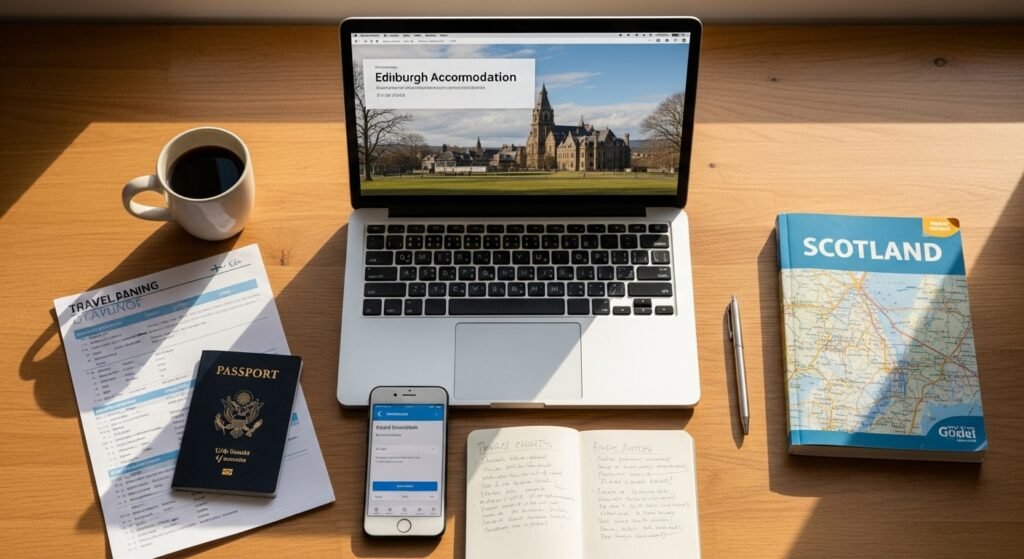
1-3 Months Before: The Specifics
Book These Now:
City hotels and B&Bs: By this point, you should nail down all accommodation. Shoulder season travelers have flexibility here, but summer visitors risk limited choices.
Popular restaurants: Edinburgh’s top restaurants book 2-4 weeks ahead. Not essential for casual dining, but if there’s somewhere specific you want to eat, reserve now.
Day tours and activities: While many accept walk-ups, booking ahead guarantees availability and sometimes offers discounts. Loch Ness boat tours, Edinburgh walking tours, and Highland day trips from cities should be sorted now.
Museum and castle tickets: Many Scottish attractions accept same-day purchases, but booking online ahead often saves money and guarantees entry during busy periods.
2-4 Weeks Before: Final Prep
Do This Now:
Reconfirm everything: Flights, hotels, rental cars, tours. Shit happens, and catching problems now beats discovering them at check-in.
Download offline maps: Google Maps and Maps.me allow offline downloads. Highland areas have spotty cell coverage—offline navigation is essential.
Notify banks about travel: Fraud prevention systems are sensitive. Tell your bank and credit card companies you’ll be in Scotland to prevent cards being blocked.
Purchase remaining gear: Waterproof jacket, UK power adapter, portable battery pack. Don’t wait until the night before to discover you’re missing essentials.
Currency exchange: Exchange a small amount (£50-100) for immediate arrival needs, though ATMs offer better rates than pre-travel exchange.
The Week Before: Last Checks
Do This Now:
Check GOV.UK for any entry requirement changes: Requirements can shift with minimal notice. Final confirmation beats arrival surprises.
Prepare document copies: Physical and digital copies of passport, ETA confirmation, travel insurance, accommodations, emergency contacts.
Set phone to airplane mode plan: Research whether you need a UK SIM card or international plan activation.
Pack strategically: Waterproof jacket accessible, not buried in checked luggage. Scotland’s weather doesn’t wait for you to dig through your bag.
Final accommodation confirmation: Send a quick email to B&Bs and small hotels confirming arrival time. Personal touches like this get better service.
The Questions Everyone Asks (But Feels Weird Asking)
Look, I’ve answered these questions about 847 times over the years, so let’s just cut through the bullshit and get you the real answers you’re actually looking for.
What month is the best time to visit Scotland?
May and September. Full stop. These are your golden ticket months.
May gives you spring blooms, temperatures that won’t freeze your ass off (10-15°C/50-59°F), and daylight that actually extends past dinner time. You’re missing the summer tourist hordes, the midges haven’t emerged from hell yet, and accommodation prices haven’t gone batshit crazy.
September? Same deal but with those ridiculous autumn colors that make you understand why people become insufferable Instagram photographers. The weather’s still decent, most tourists have gone home, and you can actually get a table at decent restaurants without booking three months ahead.
But here’s the thing—there’s no universal “best” month. If you’re chasing guaranteed sunshine (good luck with that in Scotland), aim for June-July. Want empty castles and don’t mind channeling your inner ice queen? February’s your month. Planning your whole trip around Edinburgh Festival? August, but for the love of god, book your hotel now.
The “best” time is whatever matches your personal tolerance for weather versus crowds versus prices. Pick your priority and own it.
What is the Cheapest vs Most Expensive Month to Visit?
Let’s talk money, because nobody likes nasty surprises on their credit card statement.
The Most Expensive: July and August will absolutely murder your budget. According to VisitScotland’s annual tourism report, we’re talking peak summer holidays, Edinburgh Festival madness, and every tourist in Europe descending on the Highlands simultaneously. Expect to pay 2-3 times more for accommodation during Festival season.
The Cheapest: November through February (avoiding Christmas/New Year) are bargain hunter’s paradise. Scottish tourism industry data shows accommodation prices drop by 60-70% compared to peak season. I’ve seen Edinburgh hotel rooms for £30 that cost £200 in August. The trade-off? You’ll need serious waterproof gear and a good attitude about short daylight hours.
For budget travelers, Historic Environment Scotland offers significant winter discounts on castle admissions and annual passes during off-peak months.
Let’s Be Honest: What is the Rainy Season?

First, the brutal truth: it can rain any damn time in Scotland. UK Met Office climate data shows Scottish weather plays by its own rules, with precipitation possible year-round.
The Reality: Always pack a waterproof jacket. I don’t care if the forecast shows sunshine—Scotland’s weather changes faster than a politician’s promises.
The Driest Months: April and May are statistically your best bet for staying dry, with Met Office records showing these months averaging 40-50% less rainfall than winter months, making them fantastic for hiking and outdoor adventures.
The Rainiest: October through January typically see the most persistent rainfall, but remember—Scottish rain creates those impossibly green landscapes you came to see. Scottish Environment Protection Agency data confirms this period receives 60-70% of annual precipitation.
Pro Tip: After testing dozens of rain jackets in Scottish downpours, the Berghaus Cornice jacket is my go-to recommendation. Keeps you dry without turning you into a walking greenhouse, and it’s built to handle Highland weather extremes.
The Infamous Scottish Midges: When and How to Avoid Them

Nobody talks about Scotland’s tiniest terrorists until you’re standing in a cloud of them wondering if you’ve made a terrible life choice.
When: NatureScot research confirms midge season runs from late May through early September, with July and August being absolutely brutal. These microscopic vampires love warm, humid, still conditions—exactly what Scottish summers provide.
Where: Highlands and Islands are midge central, especially near lochs and boggy areas. NHS Scotland guidance notes they’re not a major problem in cities like Edinburgh or Glasgow, concentrating in rural areas with still water.
How to Survive: Looking for battle-tested midge protection? After years of Highland adventures, these essentials have saved my sanity:
Smidge Insect Repellent – The Scottish Highland gold standard for midge protection. This stuff actually works without making you feel like you’ve been dipped in chemicals. Every local swears by it, and Forestry and Land Scotland rangers carry it religiously.
Lightweight Head Net for Hiking – Not glamorous, but when you’re surrounded by midge clouds at that perfect Highland viewpoint, you’ll thank me. Packs down to nothing and weighs less than your phone.
Dawn and dusk are when they’re most aggressive, so plan accordingly. Scottish outdoor safety guidelines recommend checking wind conditions—midges hate breezy weather almost as much as you’ll hate them.
Can You Really See the Northern Lights in Scotland?

Let’s manage expectations here—you’re not in Iceland or northern Norway. Scottish Northern Lights are possible but definitely not guaranteed.
The When: Your only real chance is December through February during the darkest months. UK Met Office Space Weather operations confirm you need clear, cold nights and solar activity cooperation.
The Where: Forget seeing them from Edinburgh or Glasgow. Head to Shetland Islands, Orkney, or the northern coast of Caithness and Sutherland according to AuroraWatch UK recommendations. The darker the location, the better your chances.
The Reality Check: I’ve lived in Scotland and seen them maybe a dozen times in twenty years. When they appear, it’s magical as hell, but don’t plan your entire trip around them. Royal Observatory Edinburgh data shows aurora visibility occurs roughly 15-20 nights per year in northern Scotland.
Aurora Photography Gear: If you’re serious about capturing the Northern Lights, a sturdy tripod is non-negotiable. The Manfrotto BeFree Carbon Fiber tripod handles Highland winds without breaking your back on long hikes, and it’s essential for the long exposures aurora photography demands.
Is Scotland worth visiting in winter?
Hell yes, but it’s a wildly different Scotland than what summer tourists experience.
Winter Scotland (December-February) gives you dramatic snow-dusted landscapes, proper cozy pub atmospheres with actual roaring fireplaces, accommodation prices that won’t make you weep (60-70% off peak season), possible Northern Lights if you’re lucky, and that authentic local experience when tourist crowds disappear and Scots remember they actually like their country.
The catch—and it’s a real one—you’re getting 7-8 hours of daylight (sunrise around 8:30 AM, sunset by 4 PM), temperatures around 2-7°C (35-45°F), persistent rain that feels less “romantic” and more “why are my socks always damp,” and some Highland roads that become genuinely dangerous or just straight-up closed. Many attractions run “winter hours” which translates to “we’re basically closed when you want to visit.”
Winter Scotland is perfect if you:
- Care more about atmosphere and killer photography than perfect weather
- Value budget savings and avoiding crowds over guaranteed sunshine
- Actually enjoy cozy indoor experiences (pubs, museums, castles without tour groups)
- Can handle cold, dark, wet conditions without becoming insufferable
- Want to experience Scotland when locals are actually there
Skip winter entirely if you:
- Need guaranteed outdoor activities and get pissed when weather disrupts plans
- Want long days for packing in maximum sightseeing
- Turn into a miserable human when cold and wet
- Have mobility concerns (icy sidewalks are no joke)
I’ve had some of my most memorable Scotland trips in winter—empty castles where I’m literally the only visitor, locals with actual time to share stories, dramatic storms rolling across lochs that make you feel like you’re in a fantasy novel. But I also pack proper gear, adjust my expectations, and don’t whine about weather I knew was coming.
Winter Scotland isn’t for everyone, but for the right traveler with the right attitude, it’s absolutely worth it.
What should I pack for Scotland weather?
Layers. Always layers. And a proper fucking waterproof jacket—I cannot stress this enough.
Scottish weather changes faster than a toddler’s mood. You’ll experience all four seasons in a single afternoon, and that’s not tourist brochure exaggeration. I’ve started days in sunshine, moved through sideways rain, experienced brief snow flurries, then back to sun—all before lunch.
Non-negotiable essentials:
- Waterproof jacket with sealed seams (not “water-resistant” which is marketing bullshit)
- Waterproof walking shoes or hiking boots
- Moisture-wicking base layers (NOT cotton—cotton stays wet and makes you miserable)
- Insulating mid-layers (wool is fantastic)
- Warm accessories (hat, gloves, scarf even in goddamn summer)
Summer additions: Sunglasses (those 18-hour days are bright as hell), sun hat, light fleece, industrial-strength midge repellent
Winter additions: Serious insulation layers, thermal underwear, waterproof gloves, warm wool socks, ice grips for shoes
The layering system is your secret weapon. You want to strip down to a t-shirt when the sun breaks through, then pile everything back on when mist rolls in five minutes later. Flexibility beats fashion every single time in Scotland.
Avoid cotton clothing—it stays wet and cold. Choose quick-dry synthetic fabrics or wool instead. Yes, merino wool base layers are expensive, but they’re worth every penny when you’re not freezing your ass off in the Highlands.
After testing dozens of rain jackets in Scottish downpours, invest in something with actual sealed seams and pit zips. Your future self standing in horizontal rain will thank you.
And for the love of everything holy, always carry waterproof gear even if the forecast shows nothing but sunshine. Scottish weather forecasts are more like gentle suggestions than actual predictions.
How many days do I need in Scotland?
Minimum seven days if you’re coming from overseas—anything less and you’re spending half your trip either in airports or recovering from jet lag while pretending you’re functional.
Seven days covers: Edinburgh highlights (3-4 days) plus one Highland region like Loch Ness or Isle of Skye (2-3 days). It’s a solid introduction without feeling like you’re speed-running through Scotland on amphetamines.
Ten to fourteen days allows: Edinburgh (3-4 days), Glasgow (1-2 days), multiple Highland regions including Isle of Skye (2-3 days) and Loch Ness area (1-2 days), plus buffer days for when Scottish weather inevitably disrupts your perfectly planned itinerary.
Three weeks enables: A comprehensive tour covering Lowlands, Highlands, Islands, whisky regions, and still having time for spontaneous discoveries when that local in the pub tells you about a hidden beach nobody visits.
Real talk: Scotland rewards slow travel over rushing through like you’re collecting Pokemon. One region explored properly beats three regions rushed through while constantly feeling behind schedule.
Consider the trans-Atlantic flight time—if you’re only taking 5-6 days total, you’re spending 20% of your trip exhausted and jet-lagged, wondering why you paid for this experience. After dragging myself through Scotland while sleep-deprived more times than I’d like to admit, my honest recommendation is minimum 7-8 days, ideally 10-14 if your vacation days and boss allow it.
Scotland has too much to offer to feel rushed. Take your time, build in weather flexibility, and don’t be that tourist with a minute-by-minute schedule that falls apart the first time it rains (which it will).
So, What’s the Verdict?
After dragging my camera gear through every Scottish season multiple times, here’s the truth: the “best” time to visit Scotland is deeply personal. It’s about matching your priorities—weather versus crowds, budget versus daylight hours, midges versus midnight sun.
My personal sweet spot? Late April through May, or September through early October. You get decent weather, manageable crowds, reasonable prices, and those stunning seasonal transitions that make Scotland feel truly magical.
Planning your perfect Scottish timing is just the first step. Once you’ve picked your season, start dreaming about where to go with our detailed 15 Prettiest Places in Scotland: Ultimate Photography Guide covering the most breathtaking locations across the Highlands and Islands.
Based on this breakdown, what month sounds perfect for your Scottish adventure? Are you willing to brave winter’s drama for those cozy pub nights, or does the midnight sun of summer call to your hiking-obsessed soul? Drop a comment and let me know—I love hearing about fellow travelers’ Highland dreams!

Pingback: Edinburgh Tattoo Secrets for First-Timers
Pingback: Planning a Trip to Scotland from US: Complete 2025 Guide
Pingback: PA Fall Foliage 2025: Photography Hot Spots